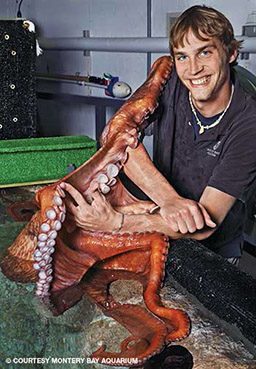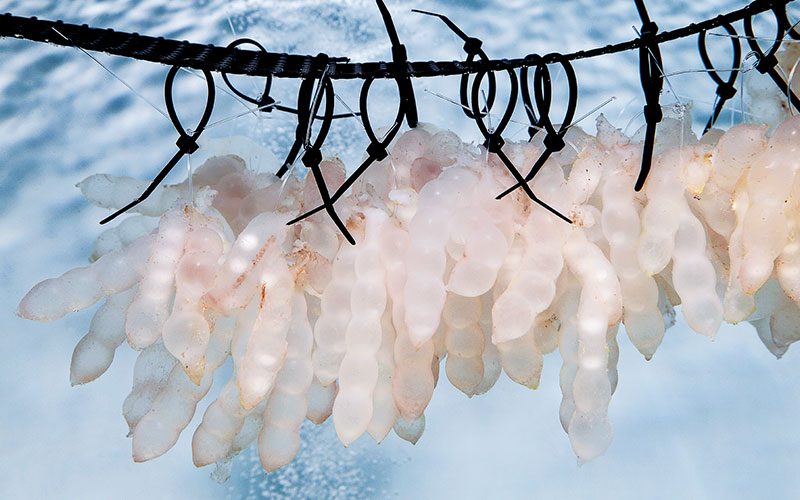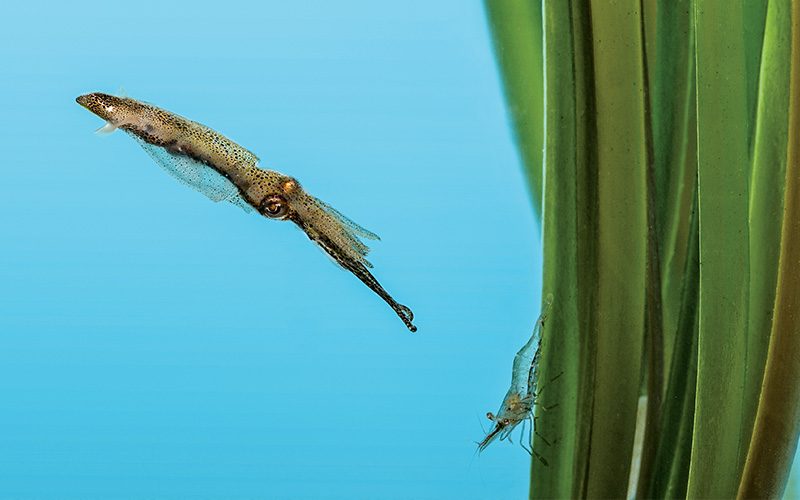If Mack and the boys stumbled out of John Steinbeck’s Cannery Row and down the street into the back door of Monterey Bay Aquarium, they might mistake it for the clandestine hatchery of an alien invasion force — think Doc Ricketts meets exobiology lab. That seemingly fanciful notion would not be far from the truth.
Throughout dark corridors in holding tanks bathed in eerie pink and blue LED lights is a growing army of hatchlings, ravenous juveniles and elusive, shape-shifting adults that represent some of the most otherworldly life forms on this planet.

Over the past two years Paul Clarkson, the aquarium’s curator of husbandry operations, and his team have been engaged in a reproductive experiment of unprecedented proportions. Their goal: to breed and raise more than two dozen species of cephalopods, the ancient class of mollusks that includes octopuses, squid and cuttlefishes.
Clarkson describes the breeding program as a monumental challenge but says it was the only way to approach a large-scale exhibition. “These animals for the most part live less than a year. They’re hard to acquire, expensive and nearly impossible to transport, and they don’t like each other,” he said, meaning that they like each other too much — most are cannibals. “We knew an exhibition would require us to source animals continually, so we decided to try to bring their full [life] cycles in house.”
“Tentacles: The Astounding Lives of Octopuses, Squid and Cuttlefishes” features more than 30 species of cephalopod that will rotate through a dozen aquatic displays. The animals hail from disparate locations ranging from the tropical Indian Ocean to the frigid, sunless depths of Monterey Bay. Nearly 5 million visitors are expected to view the almost 4,000-square-foot exhibition.
Among the octopuses showcased are the kaleidoscopic wonderpus, the highly toxic flamboyant cuttlefish and the shape-shifting mimic octopus, which can assume the form and coloration of other marine animals. There are bioluminescent Hawaiian bobtail squid, which bury themselves in the sand during the day, and one of the world’s smallest squid, the northern pygmy, which is less than an inch long. A life-size model of a giant squid, which can grow to the length of a greyhound bus, is splayed overhead along the exhibit’s ceiling.
There is also a pair of giant Pacific octopuses, a rarely seen chambered nautilus (which may have up to 90 tentacles) and various deep-sea cephalopods, including vampire squid collected from Monterey Bay by the aquarium’s sister organization, the Monterey Bay Aquarium Research Institute (MBARI). Most of these animals have never before been exhibited.

Cephalopods were once a dominant form of life on the planet, and some biologists believe they are poised for a resurgence. These stealthy marine animals boast large, intelligent brains, complex nervous systems, highly-developed senses and the ability to instantaneously change color, pattern and form in response to stimuli. They play a crucial role in marine food webs as both predators and prey in every ocean in the world from the shallows to the abyssal depths. Humans alone consume more than 2.2 billion pounds of cephalopods a year.
Though the number of cephalopod species (some 800 and counting) is dwarfed by the more than 30,000 species of fish, biologists suspect that their biomass is roughly the same, and there is evidence that biomass is increasing.
Monterey Bay Aquarium’s pioneering work comes at a time when our knowledge of cephalopods is undergoing a period of profound discovery. In the last few years, researchers captured a giant squid on film for the first time, they discovered a unique neural connection in octopuses’ arms that enables them to operate independent of the animals’ brains, identified the relationship between a squid’s light organs and the symbiotic bacteria that colonize them and discovered a truly bisexual cuttlefish that can split its coloration down the middle to resemble a female on one side and a male on the other.

MBARI researchers also recently deduced that the vampire squid, which was identified nearly a century ago, is a detritus-feeder, making it the only cephalopod known to eat nonliving food. Others discovered that although fast-swimming Humboldt squid are able to tolerate low-oxygen zones (which are increasing as a result of climate change), they are highly sensitive to the corresponding increases in shallow-water carbon-dioxide levels, which is forcing them into different regions of the ocean. Scientists are only now beginning to understand the impacts of pollution, overfishing and habitat destruction on these soft-bodied fauna.

Cephalopods have a phantasmagorical quality that has ignited and challenged human imagination for millennia. The aquarium pays homage to these deep flights of fancy with a supplemental collection of cephalopodan artwork that spans thousands of years and includes replicas of vases from ancient Crete, mosaic tiles from Pompeii and Herculeaum, scientific illustrations, murals, woodcuts, books, poetry, music, film clips, photos and three newly commissioned sculptures by Nemo Gould, the goal of which is to immerse and enthrall visitors and prompt them to consider the fate of these oceanic aliens.
As senior exhibit developer Jaci Tomulonis explained to me, “We have more success with our conservation message when we give visitors affective experiences with poetry, music, visual arts and humor and offer them concrete steps they can take.”
© Alert Diver — Q2 Spring 2014